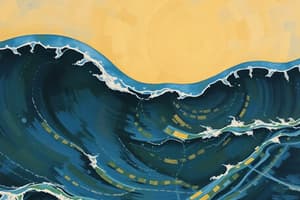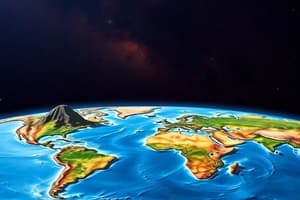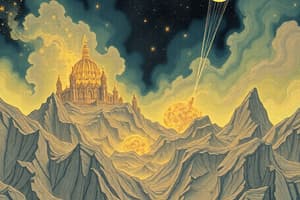Podcast
Questions and Answers
What happens to rocks near the focus during an earthquake?
What happens to rocks near the focus during an earthquake?
- They become unstable and settle into a new equilibrium. (correct)
- They remain unaffected.
- They are completely destroyed.
- They become more stable.
Which field of study focuses specifically on seismic activity?
Which field of study focuses specifically on seismic activity?
- Geophysics
- Plate tectonics
- Volcanology
- Seismology (correct)
What are aftershocks commonly caused by?
What are aftershocks commonly caused by?
- Meteorological events.
- The initial earthquake. (correct)
- Wind disturbances.
- Ocean currents.
What task is associated with the study of tectonic plates?
What task is associated with the study of tectonic plates?
Which statement is least likely to be true about the focus of an earthquake?
Which statement is least likely to be true about the focus of an earthquake?
What is a common effect of ground subsidence related to earthquakes?
What is a common effect of ground subsidence related to earthquakes?
Which condition leads to soil liquefaction?
Which condition leads to soil liquefaction?
What other ground failure mechanism is associated with ground cracking?
What other ground failure mechanism is associated with ground cracking?
Which type of material is most susceptible to soil liquefaction?
Which type of material is most susceptible to soil liquefaction?
What is not a consequence of ground failure during earthquakes?
What is not a consequence of ground failure during earthquakes?
What can cause a loss of effective stress in soil particles?
What can cause a loss of effective stress in soil particles?
What phenomenon is primarily caused by long-period seismic waves interacting with oscillations of enclosed water?
What phenomenon is primarily caused by long-period seismic waves interacting with oscillations of enclosed water?
Which feature results from ground subsidence?
Which feature results from ground subsidence?
What contributes to the formation of grabens and horsts during ground failure?
What contributes to the formation of grabens and horsts during ground failure?
Which indirect effect of earthquakes can be particularly devastating for survivors trapped in debris?
Which indirect effect of earthquakes can be particularly devastating for survivors trapped in debris?
What is the main cause of the majority of damage during an earthquake?
What is the main cause of the majority of damage during an earthquake?
How does shaking intensity affect other seismic hazards?
How does shaking intensity affect other seismic hazards?
Why is ground shaking considered the main focus of earthquake engineering?
Why is ground shaking considered the main focus of earthquake engineering?
What phenomenon occurs when elastic energy accumulates along the edges of tectonic plates?
What phenomenon occurs when elastic energy accumulates along the edges of tectonic plates?
Which of the following statements about seiches is true?
Which of the following statements about seiches is true?
What is an indirect effect of earthquakes other than ground shaking?
What is an indirect effect of earthquakes other than ground shaking?
What is the term for the specific location within the Earth where seismic energy is released during an earthquake?
What is the term for the specific location within the Earth where seismic energy is released during an earthquake?
What is the name given to the point on the Earth's surface directly above the earthquake's hypocenter?
What is the name given to the point on the Earth's surface directly above the earthquake's hypocenter?
What happens to the risk of other effects when shaking intensity is high?
What happens to the risk of other effects when shaking intensity is high?
How much can faults potentially displace due to tectonic movement annually?
How much can faults potentially displace due to tectonic movement annually?
What occurs when the rubbing and pushing between tectonic plates is prevented?
What occurs when the rubbing and pushing between tectonic plates is prevented?
What causes the brief but strong ground vibrations associated with earthquakes?
What causes the brief but strong ground vibrations associated with earthquakes?
What creates a web of smaller plates at the boundaries of tectonic plates?
What creates a web of smaller plates at the boundaries of tectonic plates?
What is the process called when tectonic plates interact and cause earthquakes?
What is the process called when tectonic plates interact and cause earthquakes?
What is the primary cause of tectonic earthquakes?
What is the primary cause of tectonic earthquakes?
Which type of plate boundary is associated with earthquakes resulting from two plates sliding past each other?
Which type of plate boundary is associated with earthquakes resulting from two plates sliding past each other?
What evidence supports the theory of continental drift?
What evidence supports the theory of continental drift?
In which layer of the Earth do tectonic plates float?
In which layer of the Earth do tectonic plates float?
Which of the following is NOT a type of plate boundary?
Which of the following is NOT a type of plate boundary?
What type of earthquake results when tectonic plates collide?
What type of earthquake results when tectonic plates collide?
Which factor is most directly related to the intensity of an earthquake?
Which factor is most directly related to the intensity of an earthquake?
Which seismic waves are known to cause the most damage during earthquakes?
Which seismic waves are known to cause the most damage during earthquakes?
What is the primary source of energy for both volcanic and tectonic earthquakes?
What is the primary source of energy for both volcanic and tectonic earthquakes?
What is the main reason why volcanic earthquakes typically affect smaller areas compared to tectonic earthquakes?
What is the main reason why volcanic earthquakes typically affect smaller areas compared to tectonic earthquakes?
What is the mechanism by which pressure changes in the surrounding rock lead to volcanic earthquakes?
What is the mechanism by which pressure changes in the surrounding rock lead to volcanic earthquakes?
What is the primary mechanism by which magma movement can induce seismic waves?
What is the primary mechanism by which magma movement can induce seismic waves?
Which of the following statements accurately describes the relative damage caused by volcanic and tectonic earthquakes?
Which of the following statements accurately describes the relative damage caused by volcanic and tectonic earthquakes?
In the context of volcanic earthquakes, what is meant by 'steady magma movement deep in the mantle'?
In the context of volcanic earthquakes, what is meant by 'steady magma movement deep in the mantle'?
Which of these scenarios can trigger a volcanic earthquake?
Which of these scenarios can trigger a volcanic earthquake?
Which of these is a key distinction between volcanic and tectonic earthquakes?
Which of these is a key distinction between volcanic and tectonic earthquakes?
Flashcards
Seiches
Seiches
Standing waves in enclosed water caused by seismic waves.
Indirect Effects of Earthquakes
Indirect Effects of Earthquakes
Consequences of earthquakes that are not directly caused by shaking, such as fires.
Ground Shaking
Ground Shaking
Primary cause of damage during earthquakes; impacts structures and may lead to further hazards.
Seismic Waves
Seismic Waves
Signup and view all the flashcards
Fire as an Effect
Fire as an Effect
Signup and view all the flashcards
Widespread Damage
Widespread Damage
Signup and view all the flashcards
Oscillations in Water
Oscillations in Water
Signup and view all the flashcards
Intensity of Shaking
Intensity of Shaking
Signup and view all the flashcards
Ground Failures
Ground Failures
Signup and view all the flashcards
Ground Cracking
Ground Cracking
Signup and view all the flashcards
Ground Subsidence
Ground Subsidence
Signup and view all the flashcards
Slope Failure
Slope Failure
Signup and view all the flashcards
Liquefaction
Liquefaction
Signup and view all the flashcards
Shear Strength
Shear Strength
Signup and view all the flashcards
Granular Soils
Granular Soils
Signup and view all the flashcards
Effective Stress
Effective Stress
Signup and view all the flashcards
Fracturing
Fracturing
Signup and view all the flashcards
Volcanic Earthquakes
Volcanic Earthquakes
Signup and view all the flashcards
Magma Movement
Magma Movement
Signup and view all the flashcards
Elastic Strain Energy
Elastic Strain Energy
Signup and view all the flashcards
Pressure Changes
Pressure Changes
Signup and view all the flashcards
Minor Damage
Minor Damage
Signup and view all the flashcards
Tectonic Earthquakes
Tectonic Earthquakes
Signup and view all the flashcards
Plate Boundaries
Plate Boundaries
Signup and view all the flashcards
Faults
Faults
Signup and view all the flashcards
Elastic Energy
Elastic Energy
Signup and view all the flashcards
Ground Vibrations
Ground Vibrations
Signup and view all the flashcards
Focus (Hypocenter)
Focus (Hypocenter)
Signup and view all the flashcards
Epicenter
Epicenter
Signup and view all the flashcards
Displacement
Displacement
Signup and view all the flashcards
Continental Drift
Continental Drift
Signup and view all the flashcards
Tectonic Plates
Tectonic Plates
Signup and view all the flashcards
Types of Plate Boundaries
Types of Plate Boundaries
Signup and view all the flashcards
Pangea
Pangea
Signup and view all the flashcards
Fossil Distribution
Fossil Distribution
Signup and view all the flashcards
Cross-section of the Earth
Cross-section of the Earth
Signup and view all the flashcards
Seismology
Seismology
Signup and view all the flashcards
Aftershocks
Aftershocks
Signup and view all the flashcards
Earth's Equilibrium State
Earth's Equilibrium State
Signup and view all the flashcards
Study Notes
Earthquake Engineering: Topic 1 - Introduction
- Earthquake effects are categorized as ground failure, indirect effects, and ground shaking.
- Ground failure includes surface rupture, ground subsidence, ground cracking, soil liquefaction, and landslides.
- Indirect effects encompass tsunamis, seiches (tidal waves in enclosed bodies of water), and fires.
- Ground shaking damage is often comparable to, or greater than, other effects.
Ground Failures
- Ground failures are a part of geotechnical earthquake engineering.
- They involve the movement of the ground surface at locations with geological fissures or weakness in the earth's crust (faults).
- Faults can slip slowly (fault creep) or suddenly (earthquake).
- Surface faulting occurs when the relative movement of rocks on either side of a fault breaks through to the surface.
- This type of ground failure often follows a pre-existing fault line.
Ground Subsidence
- Ground subsidence happens when loose soil rearranges and settles into a denser state during earthquake vibrations.
- Compaction from the vibrations can lead to substantial ground surface settlement.
Ground Cracking
- Ground cracking is frequently observed along the edges of ground subsidence.
- It can also result from slope failure or liquefaction.
- These processes cause the ground to lose support, sink, and fracture into fissures, scarps, horsts, and grabens.
Soil Liquefaction
- Soil liquefaction occurs when loose, saturated granular soils change from a solid to a liquid state.
- This happens when the shear strength is lost.
- Loose saturated sands and nonplastic silts are most vulnerable to soil liquefaction.
- In rare instances, gravel and clay can also liquefy.
- Poor drainage in loose soils is the cause of increased pore water pressure which results from the vibratory effect of seismic waves compressing the soil.
Soil Liquefaction (Illustrative Example)
- In soil liquefaction, load shifts from the soil to the pore water pressure, effectively reducing or eliminating strength.
- A slurry (soil-water mixture) can form and flow vertically to the surface, creating craters or sand boils.
Indirect Effects of Earthquakes
- Tsunamis are devastating long-period sea waves generated by vertical movement of the seafloor during earthquakes.
- They travel at extremely high speeds (over 500 mph) and are challenging to detect due to their small height to wavelength ratio (crest-to-trough height) and hundreds of miles long wavelengths in open ocean.
- Seiches are earthquake-induced waves in enclosed bodies of water such as lakes, reservoirs, or bays.
- They are caused when long-period seismic waves resonate with oscillations of the enclosed water.
- Fires are frequently a terrifying indirect effect of earthquakes because surviving trapped individuals in collapsed buildings often perish from the debris fires.
Ground Shaking
- Ground shaking is a primary cause of earthquake damage.
- Where the intensity of shaking is low, the effects from other events (e.g., landslides, tsunamis) may be negligible.
- Earthquake magnitude, location, and the characteristics of subsurface materials beneath a structure influence the shaking intensity and duration.
- Ground shaking is a major factor in earthquake engineering and design.
Types of Earthquakes
- The majority of damaging earthquakes are caused by surface fault ruptures from tectonic plate movement.
- Other sources of earthquakes can include man-made events (e.g., explosions) and volcanic activities.
- Volcanic activity can also cause earthquakes because of the shifting magma beneath a volcano.
Man-Made Earthquakes
- Man-made earthquakes are generally smaller in magnitude than other earthquake types.
- However, man-made seismic events can sometimes increase stress at plate boundaries, leading to more significant tectonic earthquakes.
- Explosions, particularly nuclear explosions, are a major cause.
- Landslides and collapse of mine/cavern roofs also produce man-made earthquakes.
- Large reservoirs also generate seismic activity from the increased weight and water pressure on existing faults.
- Hydraulic fracturing (fracking) for oil and gas extraction is controversial in relation to the increased seismic activity observed.
Volcanic Earthquakes
- Volcanic earthquakes originate from the same energy source as tectonic earthquakes—the heat from the Earth's core.
- Volcanic activity causes seismic waves when subterranean magma movement changes pressure in the surrounding rock.
- Volcanic earthquakes generate limited area shaking.
- The damage from volcanic earthquakes is typically smaller than that from tectonic earthquakes.
Tectonic Earthquakes
- Tectonic earthquakes occur when segments of the Earth's crust suddenly shift.
- Our planet's crust is segmented into tectonic plates floating on a liquid layer (mantle).
- Plate formation occurred approximately 1 to 2 billion years ago.
- Plate motions are constantly shaping continents and landmasses.
- Movement between plate boundaries produces stress that is released by rocks fracturing, resulting in an earthquake.
- Energy release creates seismic waves, and seismic waves cause ground shaking. The intensity and duration of shaking depend on the earthquake magnitude, location, and the local subsurface materials. Faults have the tendency to displace about 2 inches per year.
- Earthquakes can occur in a variety of locations around the globe.
- The epicenter is located directly over the focus, also known as the hypocenter, or origin of the earthquake.
- Seismology is the study of seismic activity.
Studying That Suits You
Use AI to generate personalized quizzes and flashcards to suit your learning preferences.




